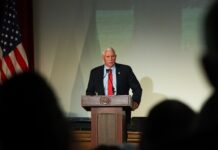Cost likely to continue to increase unless reform is passed
During the State of the University Address in September, President Cheryl J. Norton explained that one of the main factors of the predicted $28,901,329 debt that the school is expected to inherent, is the continuously rising cost of pension contribution that the school has to pay.
Norton reported that pension contribution rates are approximately 40 percent higher than last year, and will most likely increase from 20 to 30 percent each subsequent year.
“Every year we have increases very comparable to the 50 percent so where just seeing it escalate year after year,” explained Vice President of Financial Affairs, Molly Mercer. “If you look at our other costs like salary costs, or general goods and services, those are increasing two to four percent while pension cost is increasing by double digits for several years in a row.”
According to Mercer, Slippery Rock University does not decide what goes into a pension plan. Specific attributes like how much to pay employees during a retirement and how the funds are invested organization are decided by the state. So, the state set rate, and it’s the universities responsibilities to pay the amount.
Most organizations, including SRU, offer two different types of plans for faculty. They can choose between a defined contribution plan and a defined benefit plan.
Pension is a defined benefit plan. If an employee chooses this option, SRU carries commitment to pay them a certain amount of their salary for the duration of their retirement. In order to do this, the university pays a percentage given by the state of each employee’s salary per year. SRU, then has the responsibility to invest that money in order to guarantee that they can help pay the employee’s retirement plan.
“We have to be responsible for the rate of return on the investments and how those are doing and the type of benefits that are offered in the plan,” Mercer said.
In a defined contribution plan, SRU has commitment to contribute a certain amount of funds based upon the individual’s pay. The risk of how much money is available to each faculty member for their refinements falls on faculty member themself. That faculty member is the person who decides how that money is invested. When they retire, they can draw on funds that they invested.
“The contribution plan is a little bit more straight forward on the university’s side because we make the contribution, the employee invests it, and determine how they draw the funds,” Mercer explained.
According to the Keystone Pension Report of Fall 2012, the statewide pension system is 67.8 percent funded, meaning that there is a $41 billion unfunded liability. This raise in unfunded liability is why the state has continuously increased the percentage that organizations, including SRU, have to pay.
“This unfunded liability is essentially a state debt owed to state workers and public school employees,” the report explained.
Mercer explained that there is not much that SRU can do to combat the rising cost from the pension system. As of now, Pa. is looking at ways to reform the pension system to lower the cost and begin to eliminate the unfunded liability. There is no set deadline that the state has reach to pass a reform, explained Mercer.
According to Mercer, it’s hard to understand why the Pa. pension system is in the state that it is in without looking at the history of the system.
In 2001, the stock market was high, there were high investment returns. At the time, pension plans were actually overfunded by approximately 125 to 130 percent. The government passed Act 9 which substantially increased pension benefits for public employees and public school employees. Act 9 also lowered the vesting threshold, which allowed more employees to be eligible to receive benefits.
After the Sept 11 attacks, the stock market quickly declined, which caused the returns from the investments to also harshly decline. In order to recover from the loses, the amount that everyone would have had to pay for pension would have increased by a lot.
In 2002 Act 38 was passed to prevent these increases by capping employer contribution rates, and creating a Cost of Living Adjustment Plan that didn’t explain where the money would be coming from. Mercer explained that there seemed to be a belief that the economy would recover and fund the new pension plan.
By 2003, it was clear that the investments were not recovering so the State adopted Act 40, which tried to stop employers from having to pay steep contribution rates. The plan resulted in the state becoming underfunded by nearly $5.9 billion.
The most recent change to the pension plan was Act 120 which was passed in 2010. It was able to successfully lower the rising pension costs by reducing pension benefits for new employees, and increasing the retirement age for new employees to 65, among other changes.
The Keystone Pension Report explained that Pa. is currently looking at what other states are doing to handle their problems with rising pension program costs. Two of the common successful changes made are to increase the amount the each employee pays towards their own pension plan, and by increasing the retirement age by a few more years. These changes are intended to not affect current employees, people who have already retired off of pension plans, and Pa. taxpayers.







